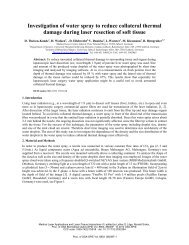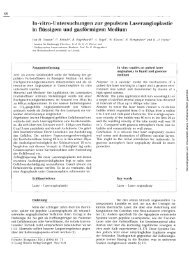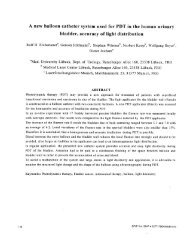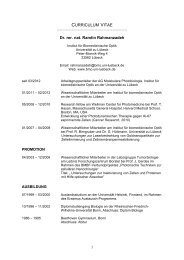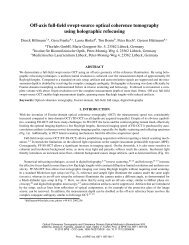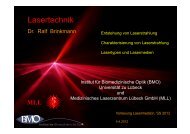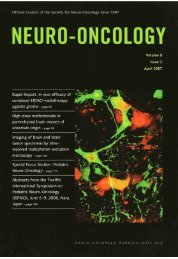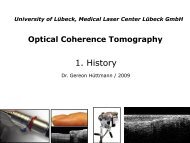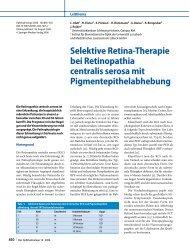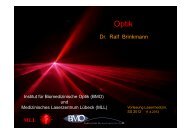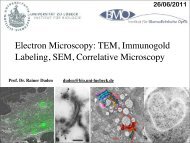Invited p aper Mechanisms of femtosecond laser nanosurgery of ...
Invited p aper Mechanisms of femtosecond laser nanosurgery of ...
Invited p aper Mechanisms of femtosecond laser nanosurgery of ...
Create successful ePaper yourself
Turn your PDF publications into a flip-book with our unique Google optimized e-Paper software.
1042 Applied Physics B – Lasers and Opticsat 530-nm wavelength to 100-ps pulses <strong>of</strong> 1064-nm wavelength.The peak irradiance used in these experiments was≈ 10 7 W/cm 2 , far below the threshold for plasma formation,and it is quite clear that in this case the <strong>laser</strong> effects reliedon two-photon-induced photochemical changes withoutthe involvement <strong>of</strong> free electrons. By contrast, the irradiancerequired to induce localized DNA damage in non-stainedchromosomes or cell nuclei was ≈ 10 11 W/cm 2 for 5.7-nspulses <strong>of</strong> 532-nm wavelength [73] and 1.9 × 10 11 W/cm 2 for120-fs pulses <strong>of</strong> 750-nm wavelength [82]. The first irradiancevalue is larger than the optical breakdown threshold inwater at the same pulse duration that was measured to be0.77 × 10 11 W/cm 2 [3]. In the second case, a three-photoninteraction can provide the energy required for molecularexcitation at the DNA absorption peak around 260 nm, butthe irradiance required for photodamage will also generatea free-electron density <strong>of</strong> ≈ 10 13 cm −3 , which borders the regionin which chemical changes may be induced by pulseseries. Eggeling et al. [204] showed that the photobleachingkinetics with <strong>femtosecond</strong> <strong>laser</strong> pulses usually involvesexcitation into higher electronic states close to the ionizationthreshold followed by photolysis, unlike for longer pulsedurations where photobleaching occurs via the triplet state.Heisterkamp et al. [84] found that slightly larger irradiancevalues than those required for photobleaching lead to ablation,a process mediated by plasma formation. Together thesefindings indicate that low-density plasmas may be involvedin the generation <strong>of</strong> ultra-short-<strong>laser</strong>-induced effects that weretraditionally exclusively attributed to direct photochemicalreactions, and may also contribute to photodamage in nonlinearmicroscopy. With increasing irradiance, free-electronmediatedchemical effects become ever more important comparedto direct photochemical reactions because the rate <strong>of</strong>free-electron generation increases very fast with irradiancedue to its high-order nonlinearity.We saw that multiphoton fluorescence excitation bearsa trade-<strong>of</strong>f between low <strong>of</strong>f-focus and severe in-focus photobleaching[204]. This raises the question <strong>of</strong> which <strong>laser</strong>pulse duration, repetition rate, and wavelength are best suitedto minimize the detrimental effects. It was found that at thesame level <strong>of</strong> photodamage pulses with 3–4-ps duration providethe same signal or even an increase in signal comparedto <strong>femtosecond</strong> pulses [202, 203, 217]. The increase in signalis due to the fact that, at constant irradiance, longer pulsesproduce a larger fluorescence excitation yield. The smallerfluorescence yield associated with the use <strong>of</strong> shorter pulsescould be compensated for by an increase in peak power if theirradiance dependences <strong>of</strong> photodamage and multiphoton ionizationwere the same. However, the irradiance dependence <strong>of</strong>photodamage is usually steeper than that <strong>of</strong> multiphoton excitation[72, 202, 203], because photodamage <strong>of</strong>ten involveshigher-order photochemical effects or even ionization. Therefore,the use <strong>of</strong> very short high-intensity <strong>femtosecond</strong> pulsesfor nonlinear imaging involves a larger risk <strong>of</strong> photodamageand seems to be neither essential nor advantageous. A prolongation<strong>of</strong> the pulse duration is, on the other hand, associatedwith an increase <strong>of</strong> average power because the peak power <strong>of</strong>the individual pulses cannot be reduced without loss <strong>of</strong> multiphotonexcitation efficiency. The upper limit <strong>of</strong> useful pulsedurations is set by the average power level leading to cumulativethermal damage. In aqueous media with low absorptioncoefficient in the wavelength range around 800 nm cumulativethermal damage is not produced for power levels up to atleast 100 mW [70, 223].Similar considerations apply for the selection <strong>of</strong> optimumrepetition rates for nonlinear imaging. The limit for themaximum useful repetition rate is defined by the rate <strong>of</strong> energydeposition for which thermal damage starts to occur.This rate depends on the NA <strong>of</strong> the microscope objective(Figs. 10 and 11), and on the linear absorption coefficient<strong>of</strong> the cells or tissues investigated. The limit is especiallylow in pigmented tissues such as skin [205], but in nonpigmentedtissues and cells even GHz repetition rates maybe used. When for pulses <strong>of</strong> constant peak power <strong>of</strong> the individualpulses the <strong>laser</strong> repetition rate was increased from80 MHz to 2 GHz, a much better signal to noise ratio could beachieved within the same image-acquisition time [220]. GHzrepetition rates can also be employed to achieve the same signalstrength with considerably smaller pulse peak power thanwith 80 MHz. This increases the safety margin with respect tophotodamage [220] and is thus <strong>of</strong> special interest for in-vivononlinear microscopy.In second- and third-harmonic imaging, the use <strong>of</strong> longerIR wavelengths than 800 nm was found to be advantageousbecause with a longer wavelength more photons are requiredfor ionization and thus the safety margin increases [86, 220].Also with regard to multiphoton microscopy, it is advantageousto use fluorophores with long excitation wavelengthsthat enable the use <strong>of</strong> longer <strong>laser</strong> wavelengths. In this way,the order <strong>of</strong> the multiphoton process can remain the samefor imaging while the number <strong>of</strong> photons required for ionizationincreases. However, if a specific fluorophore with a givenexcitation wavelength must be employed, the orders <strong>of</strong> thenonlinearities involved in image formation and photodamageincrease in a similar fashion with increasing wavelength.Therefore, the optimum wavelength must in these cases be determinedfor each individual fluorophore [77].8 Summary and conclusionsFemtosecond <strong>laser</strong> pulses enable the creation <strong>of</strong>spatially extremely confined chemical, thermal, and mechanicaleffects in biological media and other transparent materialsvia free-electron generation through nonlinear absorption.Because <strong>of</strong> the nonlinear nature <strong>of</strong> plasma formation and thedeterministic relationship between free-electron density andirradiance, effect sizes well below the diffraction limit canbe achieved. Precision and versatility are better than with cwirradiation, for which the energy deposition relies on onephotonabsorption and vital stains are <strong>of</strong>ten required to createthe necessary absorption.Free electrons are produced in a fairly large irradiancerange below the optical breakdown threshold. This lowdensityplasma regime provides a ‘tuning range’ in whichthe nature <strong>of</strong> the <strong>laser</strong>-induced effects can be deliberatelychanged by gradually varying the irradiance. Chemical effectsinduced by the free electrons and direct multiphoton interactionsdominate at the lower end <strong>of</strong> this irradiance range,whereas at the upper end they are mixed with thermal effectsand modified by thermoelastic stresses. For a sufficiently



